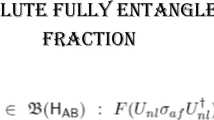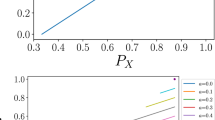Abstract
The quantumness of a generic state is the resource of many applications in quantum information theory, and it is interesting to survey the measures which are able to detect its trace in the properties of the state. In this work, we study the quantum discord and fully entangled fraction of two classes of bipartite states and compare their behaviors. These classes are complements to the \(d\otimes d\) Werner and isotropic states, in the sense that each class possesses the same purification as the corresponding complemental class of states. Our results show that maximally entangled mixed states are also maximally discordant states, leading to a generalization of the well-known fact that all maximally entangled pure states have also maximum quantum discord. Moreover, it is shown that the separability-entanglement boundary of a Werner or isotropic state is manifested as an inflection point in the diagram of quantum discord of the corresponding complemental state.


Similar content being viewed by others
Explore related subjects
Discover the latest articles, news and stories from top researchers in related subjects.References
Nielssen, M.A., Chuang, I.L.: Quantum Computation and Quantum Information. Cambridge University Press, Cambridge (2000)
Horodecki, R., Horodecki, P., Horodeck, M., Horodecki, K.: Quantum entanglement. Rev. Mod. Phys. 81, 865 (2009)
Knill, E., Laflamme, R.: Power of one bit of quantum information. Phys. Rev. Lett. 81, 5672 (1998)
Datta, A., Flammia, S.T., Caves, C.M.: Entanglement and the power of one qubit. Phys. Rev. A 72, 042316 (2005)
Datta, A., Vidal, G.: Role of entanglement and correlations in mixed-state quantum computation. Phys. Rev. A 75, 042310 (2007)
Ollivier, H., Zurek, W.H.: Quantum discord: a measure of the quantumness of correlations. Phys. Rev. Lett. 88, 017901 (2001)
Bennett, C.H., DiVincenzo, D.P., Smolin, J.A., Wootters, W.K.: Mixed-state entanglement and quantum error correction. Phys. Rev. A 54, 3824 (1996)
Zhao, M.-J.: Maximally entangled states and fully entangled fraction. Phys. Rev. A 91, 012310 (2015)
Horodecki, M., Horodecki, P., Horodecki, R.: General teleportation channel, singlet fraction, and quasidistillation. Phys. Rev. A 60, 1888 (1999)
Grondalski, J., Etlinger, D.M., James, D.F.V.: The fully entangled fraction as an inclusive measure of entanglement applications. Phys. Lett. A 300, 573–580 (2002)
Zhou, Z.-W., Guo, G.-C.: Disentanglement and inseparability correlation in a two-qubit system. Phys. Rev. A 61, 032108 (2000)
Henderson, L., Vedral, V.: Classical, quantum and total correlations. J. Phys. A Math. Gen. 34, 6899 (2001)
Luo, S.: Quantum discord for two-qubit systems. Phys. Rev. A 77, 042303 (2008)
Rulli, C.C., Sarandy, M.S.: Global quantum discord in multipartite systems. Phys. Rev. A 84, 042109 (2011)
Okrasa, M., Walczak, Z.: Quantum discord and multipartite correlations. EPL 96, 60003 (2011)
Xu, J.: Analytical expressions of global quantum discord for two classes of multi-qubit states. Phys. Lett. A 377, 238–242 (2013)
Doronin, S.I., Fel’dman, E.B., Kuznetsova, E.I.: Contributions of different parts of spin–spin interactions to quantum correlations in a spin ring model in an external magnetic field. Quantum Inf. Process. 14, 2929–2943 (2015)
Luo, S.: Entanglement as minimal discord over state extensions. Phys. Rev. A 94, 032129 (2016)
Koashi, M., Winter, A.: Monogamy of quantum entanglement and other correlations. Phys. Rev. A 69, 022309 (2004)
Shi, M., Yang, W., Jiang, F., Du, J.: Quantum discord of two-qubit rank-2 states. J. Phys. A Math. Theor. 44(41), 415304 (2011)
Vollbrecht, K.G.H., Werner, R.F.: Entanglement measures under symmetry. Phys. Rev. A 64, 062307 (2001)
Wootters, W.K.: Entanglement of formation and concurrence. Quantum Inf. Comput. 1(1), 27–44 (2001)
Terhal, B.M., Vollbrecht, K.G.H.: Entanglement of formation for isotropic states. Phys. Rev. Lett. 85, 2625 (2000)
Author information
Authors and Affiliations
Corresponding author
Appendix: Proof for Lemma 1
Appendix: Proof for Lemma 1
Proof
We provide a proof for \(2\otimes 4\) complemental state of a \(2\otimes 2\) Werner state. The generalization to higher dimensions is straightforward. The states (46) and (47) can be rewritten as follows
Having a glance of the above states, one can easily infer that the two maximally entangles states which maximize the fully entangled fraction of the state (45) should be in the following form
Now using the Eq. (2) we have
which results to
where
It is easy to show that the maximum will be reached at \(\gamma =0\) and \(\gamma ^\prime =\frac{\pi }{4}\) for an arbitrary \(\alpha \) and \(\theta \). The proof is completed and could be generalized to the higher dimensions in a straightforward procedure.
Rights and permissions
About this article
Cite this article
Behdani, J., Akhtarshenas, S.J. & Sarbishaei, M. Comparison of quantum discord and fully entangled fraction of two classes of \(d\otimes d^2\) states. Quantum Inf Process 16, 3 (2017). https://doi.org/10.1007/s11128-016-1486-6
Received:
Accepted:
Published:
DOI: https://doi.org/10.1007/s11128-016-1486-6




